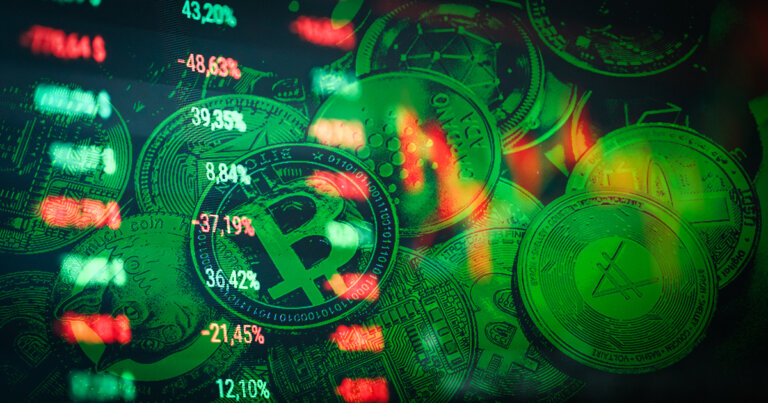 ELI5:50 Explaining crypto liquidations – The world of spot and futures crypto purchases
ELI5:50 Explaining crypto liquidations – The world of spot and futures crypto purchases ELI5:50 Explaining crypto liquidations – The world of spot and futures crypto purchases
Spot and futures trading - managing risk and riding the wave of crypto market volatility.

Cover art/illustration via CryptoSlate. Image includes combined content which may include AI-generated content.
Days like today often flash headlines of massive liquidations, while the terms ‘spot’ and ‘futures’ mystify many. Let’s break down these complex terms and their significance in the crypto market.
ELI5 (Explain Like I’m 5)
Suppose you’re at a school fair. You see a toy you want, but you only have enough tickets to buy it now (that’s spot buying). But your friend tells you he will give you the toy next week, and you can pay him the same number of tickets then (that’s a futures contract). You’re lucky if the toy becomes popular and needs more tickets next week! But you’re not so lucky if the toy gets less popular and needs fewer tickets. Now, imagine the principal says no toys can be bought or sold anymore (that’s liquidation).
ELI50 (Explain Like I’m 50)
Spot buying is like purchasing a house outright – you pay the current price, and the house is yours. Standard Futures are similar to buying a home on a contract; you agree to purchase at a future date for the current price despite fluctuations. If housing rules change and property sales are banned, that’s akin to a market liquidation event.
Perpetual futures are akin to a lease-to-own agreement for a property. You agree to make regular payments for the property, with the price adjusted based on current market values. This payment process continues indefinitely until you or the seller decide to terminate the contract, mimicking how perpetual futures work in crypto.
Spot vs. Futures crypto purchases
In the detailed context, Spot, and futures crypto purchases form the backbone of crypto trading. Spot trading is the straightforward purchase or sale of a cryptocurrency, instantly executed at the ‘spot’ or current market price. It provides immediate ownership and is typically less risky.
On the contrary, futures trading is a contractual agreement to buy or sell a particular cryptocurrency at a predetermined price at a specific future date, or in the case of perpetual futures, at any date in the future. This speculative nature of futures trading can yield high profits but also comes with significant risks, particularly in the volatile crypto market.
Perpetual futures contracts are a variant of the standard futures contracts. Unlike traditional futures with an expiry date, perpetual futures are designed to trade close to the spot price of the underlying asset and do not have an expiration date. They allow traders to hold positions as long as they want, making them attractive to long-term investors.
These contracts include funding rates that require either long or short-contract holders to pay each other based on the difference between market and contract prices. This mechanism ensures the price of the perpetual contract stays close to the underlying spot price.
Why crypto liquidations happen.
Crypto liquidations occur when traders can’t meet the margin requirements for their positions. This can happen if market prices move against a trader’s futures contract, either up or down. When a trader shorts an asset and the price goes up too far, they are liquidated, and the same in reverse.
When such a situation arises, the exchange automatically closes the position to prevent further losses, triggering a liquidation. This event causes the holder to lose the collateral they used to back up their future bet.
This is just the tip of the iceberg for crypto futures, as futures trading is highly complex. For further information, sites such as Binance Academy have a wealth of information on the topic.
However, ultimately, it is essential to remember that capital is at risk with futures trading, and that’s why we often see major liquidation events when the price of Bitcoin swings quickly in either direction. Further, there are fees to be paid on perpetual contracts, meaning the longer they are held, the more it costs cumulatively to keep the position open.
The market experiencing lots of liquidations after sudden price movements is a strong indicator of high leverage levels in the market.
Broader implications on the crypto market.
To understand the broader context, in the intricate web of global finance, crypto liquidations affect individual traders and the overall market. Large-scale liquidations can trigger sell-offs that drive down prices, creating a ripple effect in the crypto ecosystem. Simultaneously, the choice between spot and futures trading impacts liquidity and volatility in the market.
With the increasing institutionalization of cryptocurrencies, more advanced risk management tools might emerge to manage volatility and prevent large-scale liquidations. Moreover, the maturing crypto market may see a more balanced mix of spot and futures trading as traders become more experienced and regulatory landscapes evolve.
Understanding crypto liquidations and the differences between spot and futures trading is crucial for both seasoned traders and newcomers in the crypto space. As this dynamic market evolves, such knowledge will be vital in navigating the crypto world and making informed decisions.




 Arkham Intelligence
Arkham Intelligence 

 Farside Investors
Farside Investors 
 CryptoQuant
CryptoQuant 
 CoinGlass
CoinGlass 






























































































